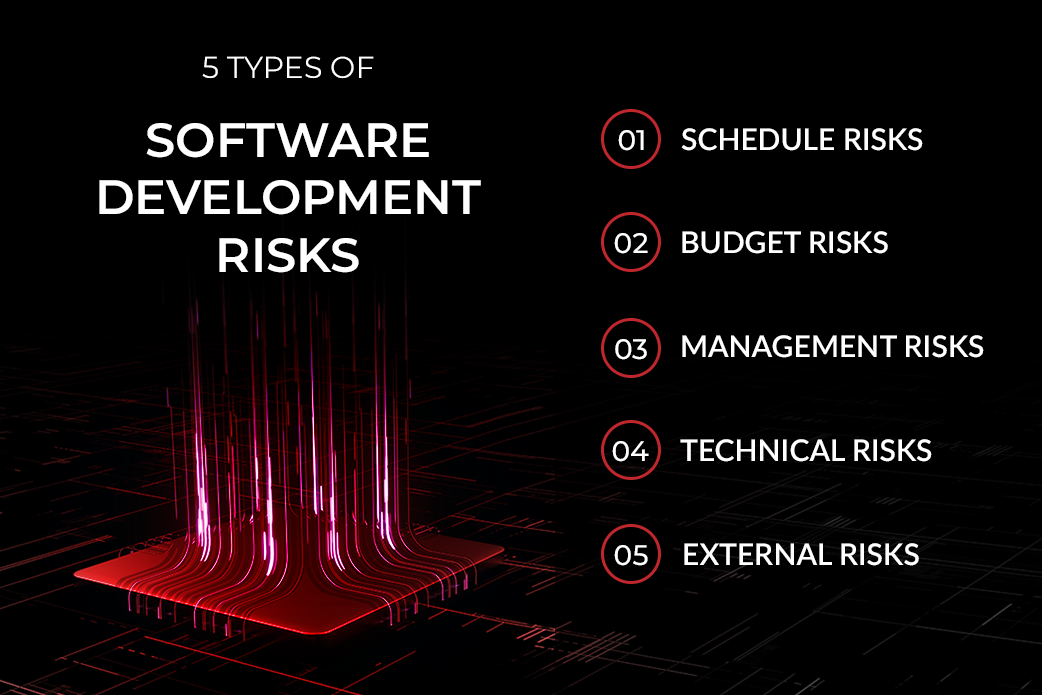Software Development Risks


Software development goes through multiple stages of design, documentation, programming, and testing, which means that it requires a high level of technical and management expertise. Ignoring risks associated with software development may result in unforeseen challenges for your business. The complex nature of software development as a process implies the proactive approach to software risk management in software engineering as it can greatly assist not only in preventing the possible pitfalls but in reducing the negative impact of the occurred events as well. 
While success is the main objective of any project, the risk comes as its inevitable part. Risks in software development are identified as the probable occurrence of loss in the future. To prevent the consequences linked to software development risks, one must know how to identify and manage them. So in case you’re wondering what is risk in software development, then here it is. Types of Risks in Software Development1. Schedule Risks There are different types of risk in software engineering and we wish to start with the most popular one. The wrong schedule affects development almost immediately. If project tasks and schedules are not addressed properly, the likelihood of project failure is high. Hence, it is important to keep in mind the areas where schedule risk is highly probable:
2. Budget Risks One of the most dangerous types of risk in software development. The finance distribution when done properly leads to reasonable use of finances and creates the grounds for project success. If the financial aspect of software development is mismanaged, there will be budget concerns. Fortunately, this is an easily avoidable risk once you know where it’s rooted:

3. Operational or Management Risks Management risks mostly occur when team structure is not clear, and the work environment prone to be toxic. Operational risk in software development leads to a situation when a team member will not be able to pursue the project or achieve software development goals. Aside from that, the surfacing of external risks in software development such as the improper process of implementation of the failed system can also affect the project. In particular, these factors include:
4. Technical Risks Technical risks arise when only a part of the developers’ team is familiar with the software. Technical risks in software development often root from the following:
5. External Risks External risks are dangerous due to their unpredictability. Therefore, it is crucial that developers had the best business analyst in the area of their market to back up ideas and eliminate business risk in software engineering created by such external factors as:
How to Identify and Manage Software Development Risks?
After inspecting categories of risk in software engineering, we glad to proceed with how to identify risks in software project issue. In every project, risks are always present. It’s just a matter of how you manage them through risk analysis in software development by containment and mitigation so when a need arises, the software development team can minimize the impact of software project risks. Here are some helpful ways to manage common risks in software development:
- Identify and classify the risks: project developers must be able to identify risks with precision, point them out and describe the possible threats in project development. The main requirement at this stage is to be accurate and efficient; then, risks can be prevented or their impact can be lessened. That is why risk assessment in software engineering is so important.
- Have a risk management plan: if risks are included in the comprehensive project plan, risk management actively responds to challenges once they arise. When you preempt an impending risk, it is more likely to reduce the impact on project development.
- Monitor and mitigate: keeping risks monitored and mitigated and mitigated is essential for successful project development.
Through Monitoring, risks can be found and dealt with immediately by making sure project status reports are updated and aligned with risk management issues.
Apart from it, a feasible and flexibly designed risk plan helps to make sure that risks do not compromise the entire project through huge changes if a risk actually surfaces. Another thing that is crucial at the stage of monitoring risks implies categorizing and prioritizing risks according to their urgency: there are risks that are to be addressed in the first place as they impose impactful threats.
You may also like:
NDA for App Development: Why Do You Need It?
Overall, gathering sample information creates a massive difference in combating future risks of all types.
✔Mitigation allows for an effective process in keeping the project development void of catastrophic threats.
Speaking of mitigation, there are several strategies that must be mentioned:
✔Avoidance: risks can be avoided by changing the parameters of the project. With this mitigation process, some risks threat impact may be reduced. However, it is important to note that avoidance should be taken with care as its overuse may lead to risks with greater repercussions.
✔Control: with a grasp on the development of a project, control refers to preempting a possible risk and creating formulated steps in removing certain risks from the agenda.
✔Transfer: knowing who exactly would handle various risks helps in keeping the project development fail-proof.
✔Continuous Monitoring: potential risks are avoidable through continuously checking the progress of project development and monitoring how the mitigation process affected surfacing risks.
Communication is key: ensuring effective communication and comprehension amongst all parties involved is crucial in eliminating the risks of miscommunication. By sharing knowledge and getting feedback, a software development project is most likely to be successful.
Concluding thought
The proper analysis, assessment, and application of risk management can prevent whatever impact it may cause in project development, most especially in custom software development.
It can also significantly improve the quality of a product and have it developed at moderate cost-minimizing risk factors within the development process. Apparently, with high regard to knowledge and orientation to detail, project development software danger can be avoided.
SEE ALSO:
In House vs Outsourcing Development
FAQ
The main types of risks in software development are divided into:
- Schedule Risk
- Budget Risk
- Operational or Management Risks
- Technical Risks
- External Risks
In software development, the risk is the error that leads to exceeding the development budget, missing the deadline, or develop a product that will not be in demand.
Everything, ranging from human errors, ending with unpredictable bugs can lead to the emergence of risky situations in the software development industry. However, usually, professionals allocate the following risky errors:
1) Change of requirements and priorities at the development stage.
2) Not enough involvement.
3) Bad communication.
4) Poor-written documentation.
5) Non-professional behavior of team members.
6) Poor feedback from the Client and other stakeholders.
7) Failure in trying to create a product faster than needed.
Build your ideal
software today

